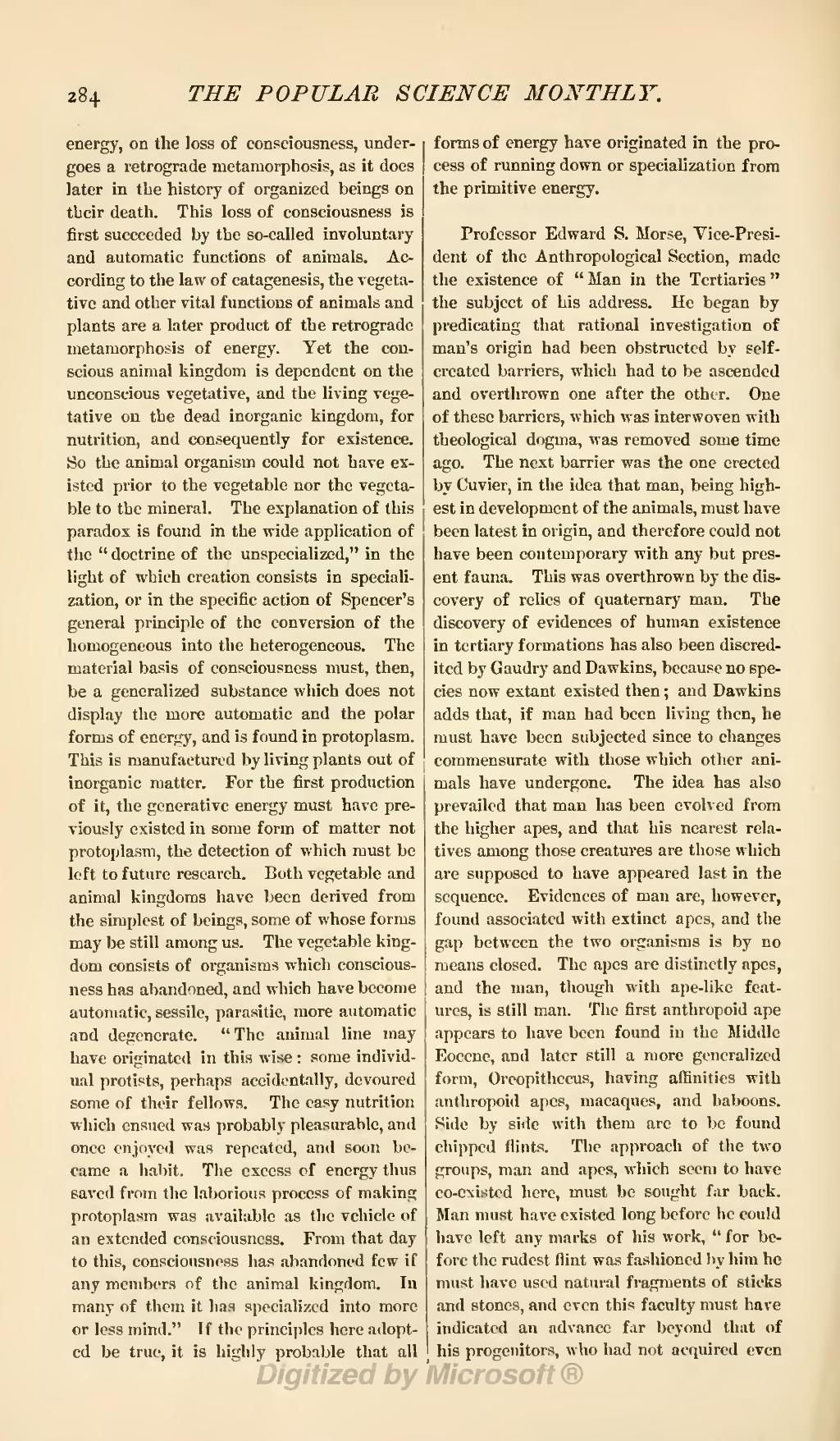energy, on the loss of consciousness, undergoes a retrograde metamorphosis, as it does later in the history of organized beings on their death. This loss of consciousness is first succeeded by the so-called involuntary and automatic functions of animals. According to the law of catagenesis, the vegetative and other vital functions of animals and plants are a later product of the retrograde metamorphosis of energy. Yet the conscious animal kingdom is dependent on the unconscious vegetative, and the living vegetative on the dead inorganic kingdom, for nutrition, and consequently for existence. So the animal organism could not have existed prior to the vegetable nor the vegetable to the mineral. The explanation of this paradox is found in the wide application of the "doctrine of the unspecialized," in the light of which creation consists in specialization, or in the specific action of Spencer's general principle of the conversion of the homogeneous into the heterogeneous. The material basis of consciousness must, then, be a generalized substance which does not display the more automatic and the polar forms of energy, and is found in protoplasm. This is manufactured by living plants out of inorganic matter. For the first production of it, the generative energy must have previously existed in some form of matter not protoplasm, the detection of which must be left to future research. Both vegetable and animal kingdoms have been derived from the simplest of beings, some of whose forms may be still among us. The vegetable kingdom consists of organisms which consciousness has abandoned, and which have become automatic, sessile, parasitic, more automatic and degenerate. "The animal line may have originated in this wise: some individual protista, perhaps accidentally, devoured some of their fellows. The easy nutrition which ensued was probably pleasurable, and once enjoyed was repeated, and soon became a habit. The excess of energy thus saved from the laborious process of making protoplasm was available as the vehicle of an extended consciousness. From that day to this, consciousness has abandoned few if any members of the animal kingdom. In many of them it has specialized into more or less mind." If the principles here adopted be true, it is highly probable that all forms of energy have originated in the process of running down or specialization from the primitive energy.
Professor Edward S. Morse, Vice-President of the Anthropological Section, made the existence of "Man in the Tertiaries" the subject of his address. He began by predicating that rational investigation of man's origin had been obstructed by self-created barriers, which had to be ascended and overthrown one after the other. One of these barriers, which was interwoven with theological dogma, was removed some time ago. The next barrier was the one erected by Cuvier, in the idea that man, being highest in development of the animals, must have been latest in origin, and therefore could not have been contemporary with any but present fauna. This was overthrown by the discovery of relics of quaternary man. The discovery of evidences of human existence in tertiary formations has also been discredited by Gaudry and Dawkins, because no species now extant existed then; and Dawkins adds that, if man had been living then, he must have been subjected since to changes commensurate with those which other animals have undergone. The idea has also prevailed that man has been evolved from the higher apes, and that his nearest relatives among those creatures are those which are supposed to have appeared last in the sequence. Evidences of man are, however, found associated with extinct apes, and the gap between the two organisms is by no means closed. The apes are distinctly apes, and the man, though with ape-like features, is still man. The first anthropoid ape appears to have been found in the Middle Eocene, and later still a more generalized form, Oreopithecus, having affinities with anthropoid apes, macaques, and baboons. Side by side with them are to be found chipped flints. The approach of the two groups, man and apes, which seem to have co-existed here, must be sought far back. Man must have existed long before he could have left any marks of his work, "for before the rudest flint was fashioned by him he must have used natural fragments of sticks and stones, and even this faculty must have indicated an advance far beyond that of his progenitors, who had not acquired even

